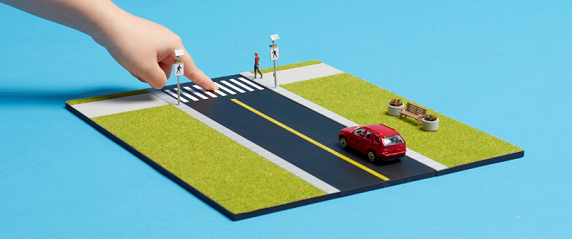Hello!
Injuries and deaths due to road accidents continue to be the biggest source of trauma and loss across the world. Though there are many reasons behind road accidents it has become clear that a strong solution is needed.
 Making transportation vehicles safer would mean fewer accidents, fewer deaths, and less loss of capital. Embracing this need, many automobile companies are committed to using smart and intelligent ways to eradicate road tragedies. Use of Electronic Logging Devices (ELD), Smartphones, CB Radio, Bluetooth Headset, Wireless Smartphone Charger, and Commercial Dash Camera will improve the safety on the roads as well as reduces the accidents and crashes by limiting drivers’ distractions. These electronic devices provide better connectivity, interoperability, security and analytics capabilities that enable intelligent and risk-free transportation.
Making transportation vehicles safer would mean fewer accidents, fewer deaths, and less loss of capital. Embracing this need, many automobile companies are committed to using smart and intelligent ways to eradicate road tragedies. Use of Electronic Logging Devices (ELD), Smartphones, CB Radio, Bluetooth Headset, Wireless Smartphone Charger, and Commercial Dash Camera will improve the safety on the roads as well as reduces the accidents and crashes by limiting drivers’ distractions. These electronic devices provide better connectivity, interoperability, security and analytics capabilities that enable intelligent and risk-free transportation.
Safety And Security In Public Transportation
Safety and security of people are the biggest challenges in public transport. Less attention is paid to towards the reasons for crashes and crimes in the public transport involving buses, trains, and airplanes because the safety level in these transport systems is considered to be adequate.
 Some of the security risks of public transport are as follows:
Some of the security risks of public transport are as follows:
- Distracted and drowsy driving
- Insufficient bus, train, or railway maintenance
- Incapable security personnel
- Defective or malfunctioning vehicles
- Operating a vehicle while intoxicated
- Lack of staff-training
Safety and security aspect in the public transportation system is very important since public transportation directly relates to human lives on a bigger scale or in huge numbers.
 Thereby, it can be improved by using best practices such as:
Thereby, it can be improved by using best practices such as:
- Technology: The technology such as CCTV and High Definition (HD) imagery are helpful in Facial recognition, scrutiny, and solving crimes.
- Crime Prevention Through Environmental Design (CPTED): It focuses on the strategic application of the natural environment to avoid crime and change the behavior which in turn builds safe and welcoming public spaces.
- Security Staffing: It requires understanding the needs of the system, developing clear roles and responsibilities across multi-security staffing types.
- Procedures and Training: These plans should outline technology, relationships and how it’s intended to be used. Training should also include operating procedures, passenger codes of conduct, and design requirements to enhance passenger safety.
Road Safety Management
 To get positive road safety results in terms of reduced roads accidents and criminal incidents, strong management is required. Today, the safe system approach is considered as the most appropriate approach in conducting and directing the management of road safety. In developed countries, system management of road safety has progressed over the last few decades. It is suggested that LMICs (Low and Middle-income Countries) must adopt this approach.
To get positive road safety results in terms of reduced roads accidents and criminal incidents, strong management is required. Today, the safe system approach is considered as the most appropriate approach in conducting and directing the management of road safety. In developed countries, system management of road safety has progressed over the last few decades. It is suggested that LMICs (Low and Middle-income Countries) must adopt this approach.
An effective road safety management system includes three related essentials which are institutional management functions, interference and outcomes. To address tough and ambitious road safety goals, each element is reviewed from time to time against the successful global practice. All countries should ensure that an effective and successful road safety management system is in place. LMICs need to fortify their road safety management systems to reduce death and serious injuries due to road accidents as do HICs when looking for better results.
Electronic Devices Help Transportation Drivers to Improve The Safety
 Smart vehicles equipped with sensors and interfaces gather real-time information on the traffic situation on different routes and show it on screen or alert the drivers through automated voice announcements. New sensors in trucks and buses will be able to observe the status of mechanical components like brakes when a vehicle is moving whereas others will provide the automatic control of driving speed and the distance maintained from the car or bus in front. Interfaces will allow data to be shared among vehicles, offering updated information on their speed and position after every 200 meters.
Smart vehicles equipped with sensors and interfaces gather real-time information on the traffic situation on different routes and show it on screen or alert the drivers through automated voice announcements. New sensors in trucks and buses will be able to observe the status of mechanical components like brakes when a vehicle is moving whereas others will provide the automatic control of driving speed and the distance maintained from the car or bus in front. Interfaces will allow data to be shared among vehicles, offering updated information on their speed and position after every 200 meters.
The auto system apps utilize a dashboard display to enable the driver to keep the focus on the road, at the same time having all of the capabilities of his Smartphone. Using such apps, the driver can answer the phone calls, make calls, receive and send text messages, and use Google Maps without taking his eyes off of the road.
Thank you!
Subscribe to our newsletter! Join us on social networks!
See you!






